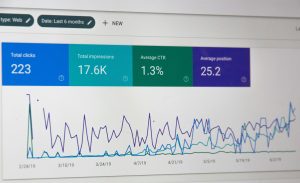Physical Address
304 North Cardinal St.
Dorchester Center, MA 02124
Physical Address
304 North Cardinal St.
Dorchester Center, MA 02124


Digital marketing has revolutionized how businesses reach and engage their target audiences. From small startups to large corporations, everyone is leveraging digital marketing to enhance their online presence and drive business growth. This comprehensive guide delves into the various facets of digital marketing, including SEO and social media marketing, to help you navigate the digital landscape effectively.
What is Digital Marketing?
Computerized promoting incorporates all advertising endeavors that utilization an electronic gadget or the web. Organizations influence advanced channels like web crawlers, virtual entertainment, email, and sites to associate with current and forthcoming clients. In today’s digital age, mastering digital marketing is crucial for any business aiming to succeed online.
The Importance of Digital Marketing
In a world where consumers are increasingly online, digital marketing offers unparalleled opportunities. It permits organizations to contact a worldwide crowd, target explicit socioeconomics, and measure the outcome of their missions continuously. Unlike traditional marketing, digital marketing provides a more cost-effective solution, making it accessible to businesses of all sizes.
Key Components of Digital Marketing
Digital marketing is a broad field, encompassing various strategies and tactics. Understanding its key components is essential for creating an effective marketing plan.
Search Engine Optimization (SEO)
Search Engine Optimization (SEO) is the process of optimizing your website to rank higher in search engine results pages (SERPs). Higher rankings lead to increased visibility, which can drive more organic traffic to your site.
On-Page SEO
On-page Web optimization includes upgrading individual pages on your site to further develop their web index rankings. This includes:
– Catchphrase Exploration: Recognizing significant watchwords that your interest group is looking for.
– Content Optimization: Ensuring your content is high-quality, informative, and includes targeted keywords.
– Meta Labels: Improving title labels, meta portrayals, and header labels.
– URL Design: Making Search engine optimization agreeable URLs that are expressive and incorporate catchphrases.
Off-Page SEO
Off-page SEO focuses on activities outside your website that can improve your search engine rankings. Key tactics include:
– Backlink Building: Acquiring high-quality backlinks from reputable websites.
– Social Media Engagement: Increasing your online presence and engagement through social media platforms.
– Guest Blogging: Writing articles for other websites to build your authority and gain backlinks.

Social Media Marketing
Social media marketing involves using social media platforms to promote your brand, products, or services. It is a powerful tool for building brand awareness, engaging with your audience, and driving traffic to your website.
Major Social Media Platforms
Different online entertainment stages take special care of various crowds and content sorts. The absolute most famous stages incorporate:
– Facebook: Ideal for reaching a broad audience and sharing a variety of content types.
– Instagram: Best for visual content and targeting younger demographics.
– Twitter: Helpful for ongoing updates and taking part in discussions.
– LinkedIn: Perfect for B2B marketing and professional networking.
– TikTok: Great for short, engaging videos and targeting Gen Z.
Social Media Strategies
An effective social media marketing strategy involves:
– Content Creation: Developing high-quality, engaging content tailored to each platform.
– Community Engagement: Responding to comments, messages, and mentions to build relationships with your audience.
– Advertising: Using paid social media ads to reach a larger audience and achieve specific marketing goals.
– Analytics: Monitoring and analyzing your social media performance to refine your strategy.
Content Marketing
Content marketing focuses on creating and distributing valuable, relevant, and consistent content to attract and retain a clearly defined audience. It aims to drive profitable customer action by providing valuable information that addresses the needs and interests of your audience.
Types of Content
Various types of content can be used in your content marketing strategy, including:
– Blog Posts: In-depth articles on topics relevant to your audience.
– Ebooks: Comprehensive guides that provide valuable insights.
– Infographics: Visual portrayals of data or information.
– Videos: Engaging and informative videos that capture your audience’s attention.
– Podcasts: Audio content that provides valuable information on specific topics.
Content Marketing Strategies
To make a successful substance promoting system, think about the accompanying:
– Audience Research: Understanding your audience’s needs, interests, and pain points.
– Content Planning: Developing a content calendar to plan and organize your content.
– SEO Integration: Optimizing your content for search engines to increase visibility.
– Advancement: Utilizing different channels to appropriate and advance your substance.
– Performance Tracking: Analyzing the performance of your content to refine your strategy.
Email Marketing
Email marketing involves sending targeted emails to your audience to promote your products or services, build relationships, and drive conversions. It is one of the most cost-effective digital marketing strategies.
Building an Email List
A fruitful email showcasing effort begins with a quality email list include:
– Opt-in Forms: Placing sign-up forms on your website, blog, and social media pages.
– Lead Magnets: Offering incentives, such as ebooks or discounts, in exchange for email addresses.
– Webinars: Hosting online events and collecting email addresses from participants.
Email Campaigns
Different types of email campaigns can be used to achieve various marketing goals, such as:
– Newsletters: Regularly updating your audience with company news, product updates, and valuable content.
– Promotional Emails: Sending targeted offers and discounts to drive sales.
– Welcome Series: Introducing new subscribers to your brand and nurturing them through the sales funnel.
– Drip Campaigns: Sending a series of automated emails based on specific triggers and user behavior.
Pay-Per-Click (PPC) Advertising
PPC advertising involves paying for ad placements on search engines, social media platforms, and other websites. Publicists pay an expense each time their promotion is clicked, making it a financially savvy method for driving traffic and produce leads.
Google Ads
Google Advertisements is one of the most famous PPC publicizing stages. It permits you to make promotions that show up on Google’s web index results pages and other Google properties.
Key parts of a Google Promotions crusade include:
– Keyword Research: Identifying relevant keywords to target with your ads.
– Ad Copy: Writing compelling ad copy that encourages clicks.
– Landing Pages: Creating optimized landing pages to drive conversions.
– Bid Management: Setting and adjusting bids to maximize your ad budget.
Social Media Ads
Social media platforms offer various advertising options to reach your target audience. Some popular social media ad platforms include:
– Facebook Advertisements: Focusing on clients in view of socioeconomics, interests, and ways of behaving.
– Instagram Ads: Creating visually appealing ads to engage with Instagram users.
– LinkedIn Ads: Reaching a professional audience with targeted ads.
– Twitter Ads: Promoting tweets and accounts to increase visibility and engagement.
Creating a Digital Marketing Strategy
An obvious computerized showcasing procedure is critical for accomplishing your business objectives. It involves several key steps:
Setting Goals
Clearly defined goals provide direction and help measure the success of your digital marketing efforts. Common goals include:
– Expanding Site Traffic: Driving more guests to your site.
– Producing Leads: Catching contact data from expected clients.
– Boosting Sales: Increasing online and offline sales.
– Improving Brand Awareness: Enhancing your brand’s visibility and recognition.
Identifying Your Target Audience
Understanding your ideal interest group is fundamental for making successful advertising efforts. Consider factors such as demographics, interests, and online behavior to identify and segment your audience.
Conducting a Competitor Analysis
Analyzing your competitors’ digital marketing strategies can provide valuable insights and help you identify opportunities for improvement. Key areas to analyze include:
– Website: Evaluating their website design, content, and user experience.
– SEO: Analyzing their keyword rankings and backlink profile.
– Social Media: Assessing their social media presence and engagement.
– Content: Reviewing the types and quality of content they produce.
Developing a Content Strategy
A solid content strategy is the foundation of your digital marketing efforts. Key steps include:
– Content Planning: Identifying topics and content types that resonate with your audience.
– Content Creation: Producing high-quality, valuable content that addresses your audience’s needs.
– Content Distribution: Promoting your content through various channels to reach a wider audience.
– Content Optimization: Continuously optimizing your content for SEO and user engagement.
Implementing Marketing Automation
Showcasing mechanization includes utilizing programming to robotize redundant advertising errands, for example, email crusades, web-based entertainment posting, and lead sustaining.
Monitoring and Analyzing Performance
Regularly monitoring and analyzing your digital marketing performance is crucial for making data-driven decisions and optimizing your strategy. Key metrics to track include:
– Site Traffic: Estimating the quantity of guests to your site and their way of behaving.
– Change Rate: Following the level of guests who make an ideal move.
– Engagement: Measuring the level of interaction with your content and social media posts.
– ROI: Calculating the return on investment for your digital marketing efforts.
Future Trends in Digital Marketing
Computerized showcasing is continually developing, and remaining on top of things is fundamental for progress. Some emerging trends to watch include:
Artificial Intelligence (AI) and Machine Learning
AI and machine learning are transforming digital marketing by enabling more personalized and efficient marketing campaigns. Applications include:
– Chatbots: Giving moment client service and commitment.
– Predictive Analytics: Forecasting future trends and customer behavior.
Personalization: Conveying fitted substance and proposals to individual clients.
Voice Search Optimization
With the rising utilization of voice-enacted gadgets, enhancing for voice search is becoming vital. This involves focusing on natural language keywords and creating content that answers common questions.
Video Marketing
Video continues to be a powerful marketing tool, with platforms like YouTube, TikTok, and Instagram offering opportunities to reach and engage a broad audience. To leverage video marketing effectively, consider creating a variety of content, such as tutorials, product demonstrations, behind-the-scenes footage, and customer testimonials. Ensure your videos are high-quality, engaging, and optimized for each platform to maximize their impact.
Influencer Marketing
Powerhouse showcasing includes collaborating with people who have a huge following via virtual entertainment to advance your items or administrations. This strategy can help you reach a larger audience, build credibility
, and drive conversions. When choosing influencers to work with, consider their relevance to your brand, their engagement rates, and the authenticity of their followers.
Interactive Content
Interactive content, such as quizzes, polls, and interactive videos, can boost engagement and provide a more immersive experience for your audience. This sort of satisfied energizes dynamic investment, making it more essential and shareable. Incorporating interactive elements into your digital marketing strategy can help you stand out and create a deeper connection with your audience.
Conclusion
Digital marketing is a dynamic and ever-evolving field that offers numerous opportunities for businesses to grow and succeed online. By understanding and implementing key components such as SEO, social media marketing, content marketing, email marketing, and PPC advertising, you can create a comprehensive digital marketing strategy that drives results. Stay informed about emerging trends and continuously analyze your performance to refine your approach and stay ahead of the competition. With a well-rounded digital marketing strategy, you can effectively reach and engage your target audience, boost your online presence, and achieve your business goals.